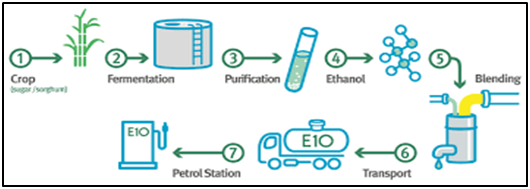What’s Happening with Centre’s Ethanol Blending Scheme
13-12-2023
10:21 AM
1 min read

What’s in Today’s Article?
- Why in News?
- About Ethanol (C2H5OH)
- About the Ethanol Blended Petrol (EBP) Programme
- Why is the Sweetener Diversion for Ethanol Production Restricted?
- Way Ahead to Increase Ethanol Production without Affecting Food Security

Why in News?
- The Ministry of Consumer Affairs, Food and Public Distribution directed all mills and distilleries not to use sugarcane juice/syrup for making any ethanol with immediate effect.
- After banning sugar exports, the Centre has taken the next step towards augmenting domestic availability - restricting diversion of the sweetener for ethanol production.
About Ethanol (C2H5OH) and Ethanol Blending
- Ethanol is an agricultural by-product which is mainly obtained from the processing of sugar from sugarcane, but also from other sources such as rice husk or maize.
- Since ethanol is produced from plants that harness the power of the sun, it is also considered as renewable fuel.
- In India, ethanol is mainly produced from sugarcane molasses by fermentation process.
- Ethanol is 99.9% pure alcohol that can be blended with petrol.
- To supplement ethanol supplies, the Government of India has permitted the procurement of ethanol produced from sources other than molasses, which is known as first generation ethanol or 1G.
- Aside from molasses, ethanol can be derived from rice straw, wheat straw, corn stover, bagasse, bamboo and woody biomass, which are known as second generation ethanol sources or 2G.
Ethanol Blended Petrol (EBP) Programme
- About:
- It was launched by the Ministry of Petroleum and Natural Gas in 2003 to promote the use of alternative and environment friendly fuels.
- This programme has been extended to the whole of India (except UTs of Andaman Nicobar and Lakshadweep islands) with effect from 1st April, 2019 wherein Oil Marketing Companies (OMCs) sell petrol blended with ethanol up to 10%.
- The all-India average blending of ethanol with petrol has risen from 1.6% in 2013-14 to 11.8% in 2022-23.
- India's goal is to grow this ratio to 20% by 2030, but when the NITI Aayog released the ethanol roadmap in 2021, that deadline was advanced to 2025.
- Benefits of EBP programme:
- It will reduce India’s import bill.
- It will reduce environmental pollution.
- It will increase farm income.
- Biofuels demand least incremental investment for manufacturers.
- Challenges when it comes to 20% ethanol blended fuel:
- Engines would need to be tweaked so as to process petrol which has been blended with 20% ethanol.
- Ethanol burns completely emitting nil CO2. However, it does not reduce the emission of another key pollutant - nitrous oxide.
- Another source of contention is inefficient land usage in ethanol production and the amount of water required to cultivate crops for ethanol.
- Food security concerns, given the uncertainties surrounding future output.
Why is the Sweetener Diversion for Ethanol Production Restricted?
- Sugar supply concerns:
- The 2022-23 sugar year ended with stocks of just over 57 lakh tonnes (lt), the lowest since the 39.4 lt of 2016-17 and way below the record 143.3 lt of 2018-19.
- Also, there is uncertainty over production for the current 2023-24 year.
- Maharashtra and Karnataka are expected to record particularly sharp declines, on the back of subpar rains and low reservoir water levels in their major cane-growing areas.
- Key takeaway from this decision:
- The latest decision, taken together with the ban on sugar shipments since May 2023, makes one thing clear.
- When it comes to domestic supply over exports, consumers over producers and food over fuel, governments privilege the former.
Way Ahead to Increase Ethanol Production without Affecting Food Security
- Alternative feedstocks:
- The government’s ethanol policy has been very supportive, especially with regard to pricing and use of alternative feedstocks (like 2G ethanol sources).
- Earlier, 100% of ethanol was from sugarcane-based feedstocks (it fell to 76% in 2022-23).
- The EBP programme no longer relies on a single feedstock or crop.
Q1) What is 3G ethanol?
Unlike the traditional method of producing ethanol from sugar-based crops, 3G or third-generation ethanol is produced by algae from wastewater, sewage or salt water.
Q2) What are flexible fuel vehicles (FFVs)?
FFVs have an internal combustion engine and are capable of running on 100% petrol or100% bio-ethanol or a combination of both.
Source: Food versus Fuel: What’s happening with Centre’s ethanol blending scheme


